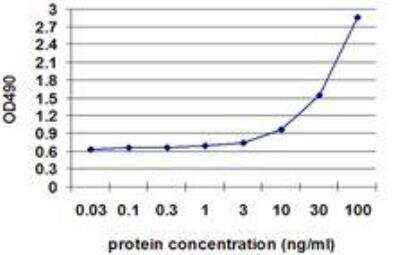MUC1 Antibody Pair
Novus Biologicals, part of Bio-Techne | Catalog # H00004582-AP41

Key Product Details
Assay Type
Sandwich ELISA
Assay Range
3 ng/ml to 100 ng/ml
Reactivity
Human
Product Specifications
Description
Quality control test: Standard curve using recombinant protein (H00004582-Q01) as an analyte. This antibody pair set comes with matched antibody pair to detect and quantify protein level of human MUC1.
Conjugate
Unconjugated
Application Notes
Reagents are sufficient for at least 3-5 x 96 well plates using recommended protocols.
Scientific Data Images for MUC1 Antibody Pair
ELISA: MUC1 Antibody Pair [H00004582-AP41]
ELISA: MUC1 Antibody Pair [H00004582-AP41] - Standard curve using MUC1 293T overexpression lysate (non-denatured) as an analyte. Sandwich ELISA detection sensitivity ranging from approximately 729x to 3x dilution of the MUC1 293T overexpression lysate (non-denatured).
Sandwich ELISA: MUC1 Antibody Pair [H00004582-AP41] - Detection sensitivity ranging from 3 ng/ml to 100 ng/ml.
Kit Contents for MUC1 Antibody Pair
- Capture antibody: mouse monoclonal anti-MUC1 IgG2b Kappa (100 ug)
- Detection antibody: biotinylated mouse monoclonal anti-MUC1 IgG2a Kappa (50 ug)
Preparation and Storage
Formulation
1x PBS, pH 7.4
Shipping
The product is shipped with polar packs. Upon receipt, store it immediately at the temperature recommended below.
Stability & Storage
Aliquot and store at -20C or -80C. Avoid freeze-thaw cycles.
Background: MUC-1
Overexpression of mucins, including MUC1, is a feature of many epithelial cancers (1,3,5,6). The presence of truncated glycan structures called tumor-associated carbohydrate antigens (TACAs) on MUC1 play a role in cancer progression and a loss of apical-basal polarity (5). Carbohydrate-binding partners called lectins are the primary binding partners of TACAs that give rise to the pro-tumor microenvironment and metastasis (5). Given this unique feature, TACAs are a potential target for cancer immunotherapies (5). There are a number of vaccines, drugs, and antibodies targeting MUC1 for treatment of a variety of cancers including breast, lung, and prostate (6). In addition to a role in cancer progression, MUC1, and specifically the CT portion, has been shown to have a positive, anti-inflammatory role in a variety of lung and airway infections (7).
References
1. Khodabakhsh, F., Merikhian, P., Eisavand, M. R., & Farahmand, L. (2021). Crosstalk between MUC1 and VEGF in angiogenesis and metastasis: a review highlighting roles of the MUC1 with an emphasis on metastatic and angiogenic signaling. Cancer cell international. https://doi.org/10.1186/s12935-021-01899-8
2. Nath, S., & Mukherjee, P. (2014). MUC1: a multifaceted oncoprotein with a key role in cancer progression. Trends in molecular medicine. https://doi.org/10.1016/j.molmed.2014.02.007
3. Dhar, P., & McAuley, J. (2019). The Role of the Cell Surface Mucin MUC1 as a Barrier to Infection and Regulator of Inflammation. Frontiers in cellular and infection microbiology. https://doi.org/10.3389/fcimb.2019.00117
4. Uniprot (P15941)
5. Beckwith, D. M., & Cudic, M. (2020). Tumor-associated O-glycans of MUC1: Carriers of the glyco-code and targets for cancer vaccine design. Seminars in immunology. https://doi.org/10.1016/j.smim.2020.101389
6. Almasmoum H. (2021). The Roles of Transmembrane Mucins Located on Chromosome 7q22.1 in Colorectal Cancer. Cancer management and research. https://doi.org/10.2147/CMAR.S299089
7. Ballester, B., Milara, J., & Cortijo, J. (2021). The role of mucin 1 in respiratory diseases. European respiratory review : an official journal of the European Respiratory Society. https://doi.org/10.1183/16000617.0149-2020
Long Name
Mucin 1, Cell Surface-associated
Alternate Names
CD227, Episialin, H23AG, KL-6, Mucin-1, PEM, PEMT
Gene Symbol
MUC1
Additional MUC-1 Products
Product Specific Notices for MUC1 Antibody Pair
This product is produced by and distributed for Abnova, a company based in Taiwan.
This product is for research use only and is not approved for use in humans or in clinical diagnosis. Antibody Pairs are guaranteed for 6 months from date of receipt.
Loading...
Loading...
Loading...
Loading...

![ELISA: MUC1 Antibody Pair [H00004582-AP41] ELISA: MUC1 Antibody Pair [H00004582-AP41]](https://resources.bio-techne.com/images/products/MUC1-Antibody-Pair-ELISA-H00004582-AP41-img0001.jpg)